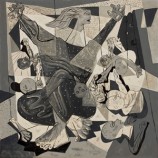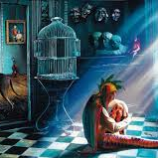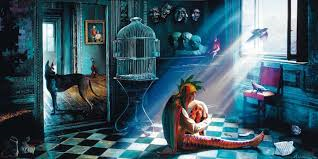Unbending intent is a sort of single-mindedness human beings exhibit; an extremely well-defined purpose not countermanded by any conflicting interests or desires; unbending intent is also the force engendered when the assemblage point is maintained fixed in a position which is not the usual one.
Sorcerers see unbending intent as the catalyst to trigger their unchangeable decisions, or as the converse: their unchangeable decisions are the catalyst that propels their assemblage points to new positions, positions which in turn generate unbending intent.
The world of daily life consists of two points of reference. We have for example, here and there, in and out, up and down, good and evil, and so on and so forth. So, properly speaking, our perception of our lives is two-dimensional. None of what we perceive ourselves doing has depth.
A sorcerer perceives his actions with depth. His actions are tridimensional for him. They have a third point of reference. Our points of reference are obtained primarily from our sense perception. Our senses perceive and differentiate what is immediate to us from what is not. Using that basic distinction we derive the rest.
In order to reach the third point of reference one must perceive two places at once. Normal perception has an axis. “Here and there” are the perimeters of that axis, and we are partial to the clarity of “here.” In normal perception, only “here” is perceived completely, instantaneously, and directly. Its twin referent, “there,” lacks immediacy. It is inferred, deduced, expected, even assumed, but it is not apprehended directly with all the senses. When we perceive two places at once, total clarity is lost, but the immediate perception of “there” is gained.
Being in two places at once is a milestone sorcerers use to mark the moment the assemblage point reaches the place of silent knowledge. Split perception, if accomplished by one’s own means, is called the free movement of the assemblage point. This all-out effort is cryptically called “reaching out for the third point.”
The third point of reference is freedom of perception; it is intent; it is the spirit; the somersault of thought into the miraculous; the act of reaching beyond our boundaries and touching the inconceivable.
To discover the possibility of being in two places at once is very exciting to the mind. Since our minds are our rationality, and our rationality is our self-reflection, anything beyond our self-reflection either appalls us or attracts us, depending on what kind of persons we are.
In terms of his connection with intent, a warrior goes through four stages. The first is when he has a rusty, untrustworthy link with intent. The second is when he succeeds in cleaning it. The third is when he learns to manipulate it. And the fourth is when he learns to accept the designs of the abstract.
Related Articles













